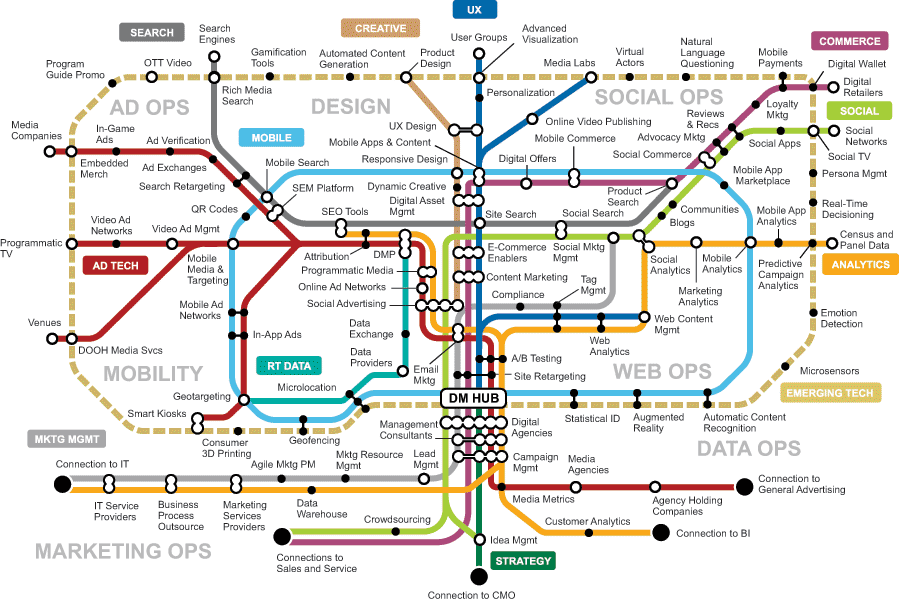
9 min readInterview with Digital Marketing Expert, Yann Gourvennec: “Digital Marketing ROI: A Necessary Evil To Be Measured With The Highest Honesty.”
September 20 2016 | Marketing
Recently, we had the chance to interview Yann Gourvennec, founder and CEO of the agency ‘Visionary Marketing’ specialized in Digital Transformation. In his interview, he shares with us his vision on how to measure the ROI of Digital Marketing.
Yann Gourvennec, you are the founder of the Digital Marketing Agency ‘Visionary Marketing’, Director of Digital Business Strategy program and author / speaker. Can you briefly introduce yourself?
I founded my Digital Marketing agency in 2014, but I created the website named Visionary Marketing in 1995. I have worked for large companies, my last experience was at ‘Orange’ as the Digital Director. I spent many years moving organizations as an intrapreneur. In 2014, I moved on the other side of the fence and I took the entrepreneurial leap.
Our agency works on digital transformation missions, content marketing (blogs, ebooks etc.) and marketing automation to large groups and medium-sized companies in France and abroad.
What is your definition of Digital Marketing ROI?
Vast subject! I have no standard definition otherwise it would be too easy. Each manager must adapt its Digital Marketing ROI calculation according to his specialty. Digital marketing is wide, as illustrated in the Gartner Digital Marketing Transit Map.
Metrics are different depending on BtoB or BtoC sector, according to its segment, Bottom Up or Top Down Market. There is no standard. A lead can cost between 5 and 1500 euros according to its business sector. The ROI on a lead for an office-supply business will be easy to measure because the purchasing decision process is short. While the ROI on a niche, such as a CIO in a specific area on a specific industry, will be more complex to analyze. Every marketing manager should create its own dashboard according to his specific needs.
In addition, many elements are possible to analyze, but however, are not necessarily interesting. Others seem insignificant from a statistical point of view and yet are crucial. For example, links referring to an element of your website will certainly be constituted of a myriad of links bringing a few visits, a “long tail” of words created by Chris Anderson, or that is precisely that long tail that makes the value of SEO, and not only the few important links that point to you. Things are not as simple as they sometimes appear to be.
Another element that does not mean anything in terms of analysis is the number of fans on Facebook, for example. It is often a metric that is presented during board meetings where people are somewhat lost with all those data, and try to cling to something known. ‘Look, we have won 200 “fans” on Facebook! Congratulations, but in terms of ROI, it’s not necessary very interesting because your commitment rate will fall accordingly.
At the opposite side of this spectrum, we can find the Word-of-Mouth Marketing (WOMM). This is a widely used tactic in Digital Marketing, inexpensive, but difficult to measure. Indeed, it is much more difficult to demonstrate the ROI of a technique that does not cost much money, than to prove the ROI of an expensive advertising campaign. Marketers like to spend, because “If I spent a lot of money, it means it’s important”, as François Laurent likes to repeat, President of Adetem, and he is right.
For Social Media in particular, ROI calculation remains a real headache. The number of views or shares may be meaningless while it is possible to make profitable a marketing operation on only one verbatim. This happened to me many times in B2B: just a good recommendation or an enthusiastic reader can make a lucrative sale.
You can't put a price on word of mouth, which is why investing in clear messaging is key. https://t.co/l5TdaSrV5d pic.twitter.com/KRlfV8jbsy
— Intercom (@intercom) September 14, 2016
For innovations, there is no ROI to measure the first years, it makes no sense. It arrives later on. Rudolf Diesel, the Diesel inventor, committed suicide because he could not sell its products. Yet today everyone uses Diesel. This extreme example is a reminder that innovation cannot bring ROI in its infancy. It also happens that embedded innovation cannot be measurable in terms of ROI. Who could prove the ROI of email at work (often decried nowadays), can be positive and how to measure it? Yet, the idea of removing the email does not make sense, some companies have paid the price. Despite this tool is time-consuming, it allows to do things no one else can replace. ROI has nothing to do with its survival or its use.
For E-Commerce, ROI is much easier to measure through the various stages of the conversion funnel.
In BtoB, marketing automation platforms help to measure and optimize ROI by pushing the user, step by step, closer to the purchasing act.
Finally, we can say that there is no standard definition of Marketing Digital ROI: the ROI calculation of a viral campaign on YouTube with a famous international actor, which costs several million euros, will not be comparable to the campaign of my last ebook that has only used word-of-mouth.
Therefore, Digital is a real paradox because we want to measure, track, register, store everything but it is impossible. Moreover, depending on the analytic tools that you are using (Webtrends, Google Analytics, WordPress, Jetpack…), even the visit figures will be different. Difficult to be peremptory, we measure everything but it is not always easy to be sure of the quality of that measure.
Measuring the ROI is nevertheless a necessary evil; it allows us to improve ourselves and to step back on the actions and analyze if our marketing actions as right or wrong. We must try to calculate it with the greatest honesty, knowing that we are sometimes unable to measure some of the variables, or that some figures are approximate.
For your agency, what are the most effective conversion trends?
Our agency offers consulting services with high added value; we receive many requests through contact forms from our website but these are not necessarily the most interesting. Most of our qualified leads come by phone after a visit on our website, a download eBook, a blog post on a referral site, social medias, conferences, interviews … We offer intellectual services and our leads want to speak with a human. This is often the case in the bottom-up B2B market. Nevertheless, in 2½ years, we closed two important deals with through a contact form.
Regarding to free trials, we have set up ‘Free flash audits’ but we stopped. After that campaign, we carried out a free audit but it didn’t transform. However, in some industries, like for SaaS softwares, free trial works very well and is even almost mandatory. The user can switch from the free plan to a paid plan in one click.
Again there is no miracle solution, but some tailored to each market, to each shopping cart, to each sector.
We can see that most metrics and analytics ignore phone conversions. Is your ROI calculation completely wrong?
Yes definitely, especially with the rise of mobile phones: 30% of our readers are mobile. The first point of contact for a company is its website, that is why it is very important to have an updated website with powerful CTA. Indeed, almost 89% of Internet users are searching online before purchasing a product according to Google. But once users are on your website, they may want to ask you a question, ask for an appointment and they want an answer quickly. Otherwise, they switch to your competitors.
In addition, there are some sectors where advice and sales over the phone are very important. In BtoB, the more we go up the market, the more you need people to answer questions in a personalized way, either by phone, either by online chat.
The more we go down the market, in the sector of ecommerce for example, some automated live chat (chat bots) will develop as questions and answers are quick and well identified.
The main challenge for marketers and agencies today is to prove and improve their digital ROI (especially through the notion of leads attribution): according to you, what challenges do they face?
The main difficulty that I meet with my clients in the ROI calculation is the leads follow-up. My clients have often planned and organized everything: the website, marketing campaigns, distribution, but the last kilometer has been neglected: who will contact the lead? Is my sales team well-enough prepared to answer to all the incoming calls generated by my lead generation campaign?
In the different missions I lead, I too often meet some sales teams reluctant to new inbound marketing techniques. I see too many leads that are not getting called back. It only takes a few hours to the website visitor to forget its last visit: 90% of the information to which he is exposed disappear after 18 seconds. It is difficult for an internet user to remember all the websites he has visited, at the end of its 4 daily hours of web browsing. So, if you call back that lead on the next day and you begin your call by ‘you came on our website yesterday…’, you have 9 changes over 10 that that user does not remember neither your website, neither your brand, neither its visit. Bad news for your ROI.
According to you, what are the main Digital Marketing KPI to track and monitor?
Here are the main quantitative interesting KPIs to measure:
– Web Traffic: If you do not have traffic on your website, it will be difficult to develop brand awareness; so it is interesting to analyze metrics such as the number of visitors, the bounce rate (with all precaution), the average session duration, the average page views per visit, the rate of return visitors to your website.
– Traffic sources: Long-tail SEO keywords, online advertising, referring sites, social medias.
– Leads conversions: Traffic is great, but unless it converts, it’s pointless. You have to distinguish qualified leads (that might become prospects and customers) from unreliable leads. So you need to know how to identify the qualified lead conversion rate following a download eBook, a free trial, a webinar, a contact form etc. versus the customer conversion rate. This will allow you to compare your total marketing investment with the turnover it generates.
Yann Gourvennec, thank you for answering our questions.
To know more about Yann Gourvennec’s vision of Digital Marketing:
- 3 books co-written with Hervé Kabla On Digital Marketing
- An ebook on the reform of social media studies & research co-written with Rozenn Nardin Social Media Listening, du bruit au signal.
And you, what Marketing KPIs do you track and monitor? Share them with us in the comments section below!
